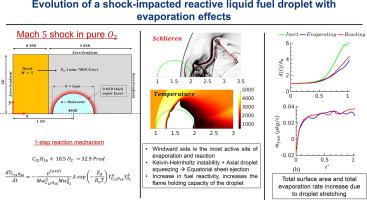当前位置:
X-MOL 学术
›
Int. J. Multiphase Flow
›
论文详情
Our official English website, www.x-mol.net, welcomes your feedback! (Note: you will need to create a separate account there.)
Evolution of a shock-impacted reactive liquid fuel droplet with evaporation effects: A numerical study
International Journal of Multiphase Flow ( IF 3.8 ) Pub Date : 2024-01-24 , DOI: 10.1016/j.ijmultiphaseflow.2024.104744 Prashant Tarey , Praveen Ramaprabhu , Jacob A. McFarland
International Journal of Multiphase Flow ( IF 3.8 ) Pub Date : 2024-01-24 , DOI: 10.1016/j.ijmultiphaseflow.2024.104744 Prashant Tarey , Praveen Ramaprabhu , Jacob A. McFarland

|
We describe detailed numerical simulations of a liquid fuel droplet impacted by a Mach 5 shock wave, considering the effects of chemical reactions and phase change due to evaporation. In our baseline case, a , fuel droplet is preheated to , and surrounded by preheated gas at . The simulations investigate the low Ohnesorge number regime , where viscous effects are insignificant and therefore not considered in this work. The fuel droplet undergoes significant deformation and morphological changes following shock impingement, as the droplet surface becomes unstable to the Kelvin-Helmholtz instability. The droplet core is also observed to eject a thin sheet near the equatorial plane, which is then stretched by the high-speed post-shock gas flow, affecting the late-time behavior. We find the observed dominant modes associated with the Kelvin–Helmholtz instability are in reasonable agreement with inviscid linear theory (Chandrasekhar, 1981; Jepsen et al., 2006), when the local conditions at the droplet surface are considered. Furthermore, an evaporation-induced Stefan flow is established which blows off the hot post-shock gases surrounding the droplet, leading to droplet cooling. As the fuel vapors react, a diffusion flame is formed on the droplet-windward side, leading to intense droplet heating and enhanced vapor production in this region. We investigated the effect of the Damkohler number on droplet evolution by varying the fuel reactivity, and found the flame thickness decreased with increasing reactivity in agreement with trends predicted by laminar diffusion flame theory. At the highest reactivity, secondary burning of fuel vapors was observed in the droplet wake, while the resulting flame eventually reattached to the droplet surface. Our results show significant spatial inhomogeneities are present in the droplet flowfield in all the cases investigated, which must be considered in the development of reduced order point-particle models for system-level simulations of detonation engines.
中文翻译:

具有蒸发效应的冲击反应反应液体燃料液滴的演化:数值研究
我们描述了受 5 马赫冲击波影响的液体燃料液滴的详细数值模拟,考虑了化学反应和蒸发引起的相变的影响。在我们的基线情况下,燃料滴被预热至 ,并被预热气体包围。模拟研究了低 Ohnesorge 数状态,其中粘性效应微不足道,因此在本工作中不予考虑。由于液滴表面因开尔文-亥姆霍兹不稳定性而变得不稳定,燃料液滴在冲击冲击后经历显着的变形和形态变化。还观察到液滴核心在赤道面附近喷射出薄片,然后该薄片被高速震后气流拉伸,影响后期行为。我们发现,当考虑液滴表面的局部条件时,观察到的与开尔文-亥姆霍兹不稳定性相关的主导模式与无粘线性理论相当一致(Chandrasekhar,1981;Jepsen 等人,2006)。此外,建立了蒸发引起的斯特凡流,吹走液滴周围的热后激气体,从而导致液滴冷却。当燃料蒸气发生反应时,在液滴迎风侧形成扩散火焰,导致该区域的液滴强烈加热并增强蒸气产生。我们通过改变燃料反应性研究了达姆科勒数对液滴演化的影响,发现火焰厚度随着反应性的增加而减小,这与层流扩散火焰理论预测的趋势一致。在最高反应性下,在液滴尾流中观察到燃料蒸气的二次燃烧,而产生的火焰最终重新附着在液滴表面。我们的结果表明,在所有研究的情况下,液滴流场中都存在显着的空间不均匀性,在开发用于爆震发动机系统级模拟的降阶点粒子模型时必须考虑这一点。
更新日期:2024-01-24
中文翻译:

具有蒸发效应的冲击反应反应液体燃料液滴的演化:数值研究
我们描述了受 5 马赫冲击波影响的液体燃料液滴的详细数值模拟,考虑了化学反应和蒸发引起的相变的影响。在我们的基线情况下,燃料滴被预热至 ,并被预热气体包围。模拟研究了低 Ohnesorge 数状态,其中粘性效应微不足道,因此在本工作中不予考虑。由于液滴表面因开尔文-亥姆霍兹不稳定性而变得不稳定,燃料液滴在冲击冲击后经历显着的变形和形态变化。还观察到液滴核心在赤道面附近喷射出薄片,然后该薄片被高速震后气流拉伸,影响后期行为。我们发现,当考虑液滴表面的局部条件时,观察到的与开尔文-亥姆霍兹不稳定性相关的主导模式与无粘线性理论相当一致(Chandrasekhar,1981;Jepsen 等人,2006)。此外,建立了蒸发引起的斯特凡流,吹走液滴周围的热后激气体,从而导致液滴冷却。当燃料蒸气发生反应时,在液滴迎风侧形成扩散火焰,导致该区域的液滴强烈加热并增强蒸气产生。我们通过改变燃料反应性研究了达姆科勒数对液滴演化的影响,发现火焰厚度随着反应性的增加而减小,这与层流扩散火焰理论预测的趋势一致。在最高反应性下,在液滴尾流中观察到燃料蒸气的二次燃烧,而产生的火焰最终重新附着在液滴表面。我们的结果表明,在所有研究的情况下,液滴流场中都存在显着的空间不均匀性,在开发用于爆震发动机系统级模拟的降阶点粒子模型时必须考虑这一点。



























 京公网安备 11010802027423号
京公网安备 11010802027423号